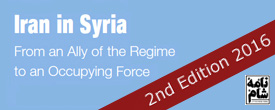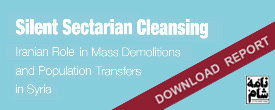Under the title ‘Whose Sarin?’, the renowned investigative journalist Seymour Hersh published an article in the London Review of Books in early December 2013 about the Ghouta chemical attack near Damascus in August 2013 (http://www.lrb.co.uk/v35/n24/seymour-m-hersh/whose-sarin).
Hersh claims that the Obama administration “cherry-pickedintelligence [on the use of chemical weapons in Syria] to justify a strike against Assad”, and that the radical Islamist armed group Jabhat Al-Nusra had “mastered the mechanics of creating sarin and was capable of manufacturing it in quantity.”
The article has been used by the Syrian regime and its allies as “further evidence” that it was the Syrian opposition and not the regime who carried out the Ghouta massacre (about 1,400 people were killed). So we thought we should draw our readers’ attention to what analysts are saying about Hersh’s claims.
A few important things to note:
– Hersh usually publishes his investigations in the respectable New Yorker magazine or the Washington Post, where this article was initially supposed to appear. Instead, the article was published in the London Review of Books, which has become a hub for anti-imperialist conspiracy theorists. In a recent interview with Democracy Now, Hersh admitted that the Washington Post editors informed him that “the information [Hersh] got… didn’t meet the standards of The Washington Post.” (http://www.democracynow.org/2013/12/9/seymour_hersh_obama_cherry_picked_intelligence)
– Hersh’s sources are not very reliable. The “former senior intelligence official” quoted in the article is likely to be – based on the information given – none but F. Michael Maloof, a controversial veteran Pentagon employee under the Bush administration. The former staff in the US Undersecretary of State of Defense’s office was “stripped of his security clearance” in 2003 but had been a key player in the effort to find links between former the Iraqi dictator Saddam Hussein and Al-Qaeda in the lead-up to the Iraq war. Maloof also reportedly had dealings with the Syrian regime in the past, as a “communications channel” between Syria and the US Defense Department, through a dodgy Lebanese-American businessman called Imad Haji. (http://www.informationclearinghouse.info/article5165.htm)
– Maloof had made very similar claims to those of Hersh (that US government had intelligence confirming that Jabhat Al-Nusar and Al-Qaeda in Iraq were capable of manufacturing and using sarin), claims he made on – surprise, surprise! – Russia Today (http://rt.com/op-edge/syria-rebels-have-sarin-980/) and Press TV (http://www.presstv.com/detail/2013/03/15/293757/alnusra-waiting-for-eu-assist-in-syria/).
– Hersh does exactly what he accuses the Obama administration of doing: cherry-picking ‘evidence’ to support an ideologically or politically driven claim. For example, his supposed expert on rockets, Prof. Theodore Postol, misrepresents the UN report into the chemical attack, claiming the UN inspectors only found and analyzed one rocket – when they had, in fact, found two – and that this rocket “fails to match the specifications of a similar but smaller rocket known to be in the Syrian arsenal” and the maximum range of the rocket was 2 kilometres, suggesting it must have been “improvised munition that was very likely manufactured locally” and could have only been fired from a rebels-held area.
Eliot Higgins of Brown Moses, who is widely regarded as a knowledgeable expert on the Assad regime’s use of weapons, has written extensively on this question and concluded that the two rockets found by the UN inspectors were a Soviet M14 140 mm artillery rocket, held only by Syrian regime forces, and a ‘Volcano’ rocket, also used by pro-regime units. (See http://brown-moses.blogspot.ae/2013/09/who-was-responsible-for-august-21st.html and http://brown-moses.blogspot.fr/2013/11/new-key-evidence-in-understanding.html. See also this video:https://www.youtube.com/watch?v=eklJbS4Iv7I.)
The question we, Iranians, should ask is: How can the Iranian government still support a regime that used chemical weapons against civilians? Does that make it complicit in this war crime?
Other well-researched responses to Hersh’s article:
– Eliot Higgins, “Sy Hersh’s Chemical Misfire”, Foreign Policy, 9 December 2013, http://www.foreignpolicy.com/articles/2013/12/09/sy_hershs_chemical_misfire#sthash.bMCue1XH.APmouRPS.dpbs
– Dan Kaszeta, “Why Seymour Hersh has it wrong this time”, Now, 10 December 2013, https://now.mmedia.me/lb/en/commentaryanalysis/524969-524969-why-seymour-hersh-has-it-wrong-this-time
– Joanna Paraszczuk and Scott Lucas, “Syria Special: Chemical Weapons Conspiracy That Wasn’t — Hersh’s ‘Exclusive’ Dissected”, EA WorldView, http://eaworldview.com/2013/12/syria-special-chemical-weapons-conspiracy-wasnt-seymour-hershs-exclusive-dissected/
Other important articles and reports on the Ghouta chemical attack:
– Adam Entous, Nour Malas and Rima Abushakra, published in the Wall Street Journal on 22 November 2013: http://online.wsj.com/news/articles/SB10001424052702303914304579194203188283242
– The UN report into the Ghouta chemical attack can be found here:
– The Human Rights Watch report:http://www.hrw.org/node/118725
– The Syrian Network for Human Right report on other chemical attacks by the Syrian regime:
http://www.syrianhr.org/reports/syrian-network-for-human-rights-report-24-07-2013-10.pdf
For a detailed account of another, previous controversy surrounding the Gouta chemical attack (the Mint Press fiasco), see this detailed analysis by Nafeez Mosaddeq Ahmed:
https://ceasefiremagazine.co.uk/syria-deciphering-propaganda-war-ghouta-massacre/
 English
English  فارسی
فارسی  العربية
العربية 




 On Twitter
On Twitter